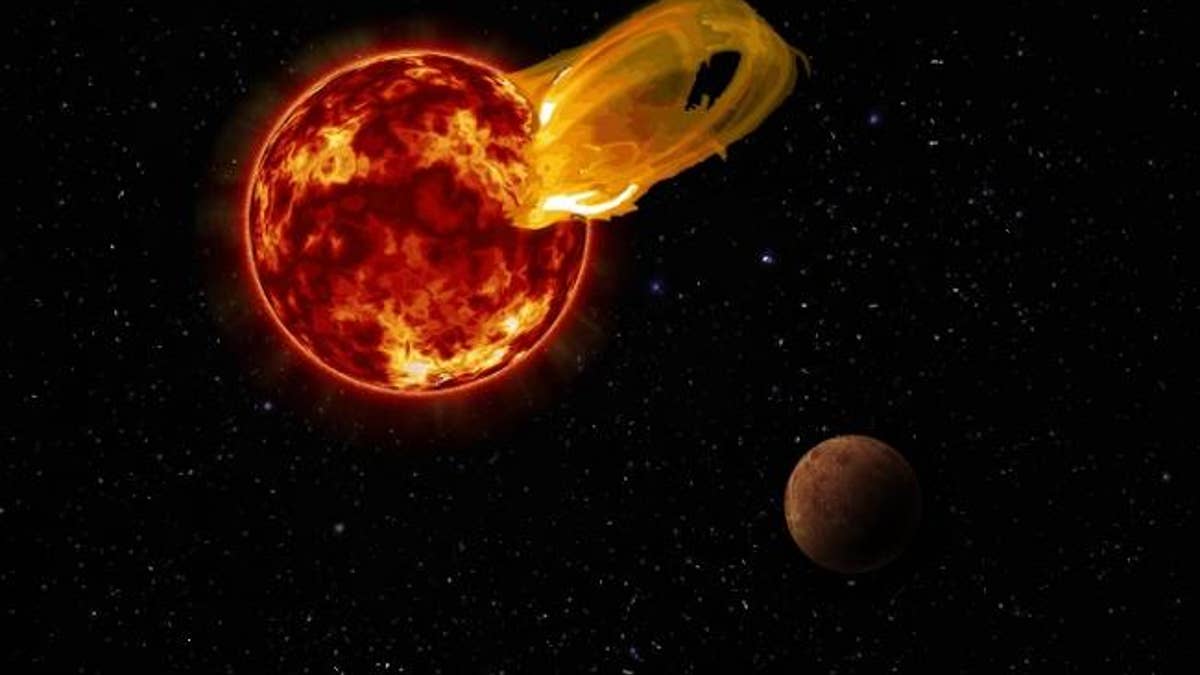
Artist's illustration of a powerful flare erupting from the red dwarf star Proxima Centauri. (Roberto Molar Candanosa/Carnegie Institution for Science, NASA/SDO, NASA/JPL)
There's something odd about our solar system.
We thought we were normal. After all, we were the only system of planets we knew.
That was two decades ago.
But hunters have now discovered planets orbiting some 500 stars. They’re finding more every year. Others have been looking at the ‘stuff’ surrounding these stars — the leftover bits of their birth.
And very, very few of these solar systems look anything like ours.
Astronomers are starting to think they have an idea why.
INTERSTELLAR WAKE-UP CALL
Just 70,000 years ago, we likely had a close encounter.
Our early ancestors — and their cousins, the Neanderthals — could have looked up to see a strange red flicker in the night sky.
It was a mysterious wanderer.
It was close. But it would have been faint. Red dwarf stars shine mostly in the infra-red spectrum. At regular intervals, however, it was likely to have spat out immensely bright flares that would have been easily visible from Earth, astronomers believe.
The alien star would have perplexed the Neanderthals who had spread across Europe and parts of Asia by this time. Homo Sapiens were only just considering taking their first steps out of Africa.
Every flash would have come from a different spot in the sky as the star zoomed past.
That would have been spooky.
Even then, our early ancestors would have been familiar with the steady wheel of familiar stars and planets.
Now, according to research by astronomers at the Universities of Madrid and Cambridge, the erratic path of some of the most distant objects orbiting our Sun are further evidence something happened in our night skies at the dawn of humanity.
The idea of a wander was announced in 2015 by Professor Eric Mamajek of the University of Rochester. They pointed the finger at Scholz’s Star — a small red dwarf with an orbiting brown dwarf (a star that failed to ignite) now some 20 light years away.
It’s barely 10 percent the size of our Sun. But an analysis of its trajectory gives it an extremely high likelihood of having recently passed through the solar system’s Oort cloud — a cloud of trillions of icy rocks at the edge of the Sun’s gravitational influence.
Now astronomers have noticed an unusual ‘bundling’ of Oort objects.
“The pronounced over-density appears projected in the direction of the constellation of Gemini, which fits the close encounter with Scholz’s star,” the researchers wrote.
STIRRING THE POT
Astronomers also think the odd orbits of our solar system could be a hint as to why our planets seem to be … out of order.
Our biggest gas giant — Jupiter — appears closer than most. And our inner planets are oddly all rocky.
A new study suggests things here may have been jumbled up when a star cut through our solar system during its embryonic phase.
“Our group has been looking for years at what fly-bys can do to other planetary systems never considering that we actually might live right in such a system”, says Susanne Pfalzner, the leading author of the project. “The beauty of this model lies in its simplicity.”
She says a star may have ‘stolen’ much of the Sun’s outer protoplanetary disc — the rubble of rock and ice that is the building blocks of planets.
“It turned out that the best fit for today’s outer solar systems comes from a perturbing star which had the same mass as the Sun or somewhat lighter (0.5-1 solar masses) and flew past at approximately 3 times the distance of Neptune,” the statement reads.
But the research does not only explain the odd behavior of our outer solar system. It also suggests why Neptune and Uranus are the uncommonly small size they are.
Pfalzner says our Solar System likely has many more dwarf planets — and possibly even the elusive Planet 9 — awaiting discovery because of this early ‘shake’n’bake’ session.
MORE TO COME
Another rogue star has been spotted heading our way. And our descendants may get to see it up close — in about 1.29 million years.
Astronomers have been watching Gliese 710 for some time. That’s because they can see it’s coming at us.
The question has simply been a matter of when, not if.
Gliese 710 is about 60 percent the size of the Sun. It’s been clocked moving at some 51,500kmh. Now, analysis by researchers at the University of Madrid has narrowed down its expected arrival time from about 1.35 million to the new figure.
“Our results … suggest a closer, both in terms of distance and time fly-by of Gliese 710 to the solar system,” the researchers wrote in a new paper.
That means it’s going to be a closer call than initially expected.
Close, however, is relative. Their calculations place it some 100 times further out than Pluto.
But, given Gliese 710’s size, it will still have the potential of disrupting our solar system.
Like Scholz’s Star, the inner planets will be fine. But the comets in the Oort cloud could be thrown into disarray.
Some would begin the long fall down the Sun’s gravity well.
And that could be a problem.
This story originally appeared in news.com.au.
